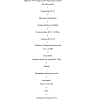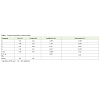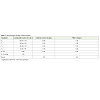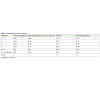Research Article
Studies on Quality Evaluation of ProbioticCustard Apple (Annona Reticulata) Dahi
M S Patil, PT Dhole and KD Chavan*
Corresponding author: Dr. KD Chavan, Department of Animal Husbandry & Dairy Science, Mahatma Phule KrishiVidhypeeth, Rahuri, Dist. Ahmednagar, PIN-413 722, Maharashtra, India; E-mail: krishnachavan158@gmail.com
Citation: Patil MS, Dhole PT, Chavan KD. Studies on Quality Evaluation of Probiotic Custard Apple (Annona Reticulata) Dahi. Indian J Nutri. 2015;2(1):110.
Copyright © 2015 KD Chavan et al. This is an open access article distributed under the Creative Commons Attribution License, which permits unrestricted use, distribution, and reproduction in any medium, provided the original work is properly cited.
Indian Journal of Nutrition | Volume: 2, Issue: 1
Submission: 30/06/2015; Accepted: 18/07/2015; Published: 25/07/2015
Abstract
The probiotic dahi samples were prepared by using Lactobacillus acidophilus starter culture. The total solids content of cow milk were raised by additionof custard apple powder i. e. 1,2,3,4 and 5P% levels. Prepared Probiotic dahi samples were evaluated for its sensory quality for finalization of experimentaltreatments. On the basis of sensory parameters of dahi samples. Custard apple powder levels viz; 1, 2, 3 and 4% were finalized for experimental trials.Experimental dahi samples were evaluated for chemical, microbiological and sensory qualities.
Fat and protein contents of dahi samples were ranged from 3.35 to 3.51% and 3.23 to 3.31%, respectively. The lactic acidity and total solids of dahisamples were 0.65 to 0.83% and 12.00 to 15.03% , respectively. Total solids content increased significantly (P < 0.05) due to addition of various levels ofcustard apple powder in the dahi. The lactic acidity of the dahi samples ranged from 0.65 to 0.83%. Total viable counts of L. acidophilus of dahi samples wereranged from 22.5x106 to 26.25 106 cfu/gm whereas the coliform counts and Yeast and mould counts ( YMC ) were ranged from 0.25 to 0.50 and 0.33 to 1.50cfu /gm in the samples. Organoleptic quality of dahi samples observed in the study was also significantly ( p < 0.05) improved. Better quality probiotic custardapple dahi can be prepared by using cow milk containing 12% total solids, 2% custard apple powder and 1 % starter culture of Lactobacillus acidophilus strain.
Keywords: Probiotic dahi; Chemical quality; Microbiological quality; Organoleptic quality
Introduction
The process of souring of fermentation of milk is one of theoldest method known for preserving milk constituents. Thefermented milk products have reputation due to their nutritionaland therapeutic properties from the time immemorial. Fermentedmilk products are easily digested because of breaking down ofprotein into peptides and free amino acids. Fermentation of milkconverts lactose into lactic acid and other biochemical whichstimulate gastric secretion and speed up the transport of gastriccontents into the intestinal tract. This lactic acid suppressesthe growth of putrefactive bacteria which are associate withconstipation [1].
Dahi is one of the most important fermented milk product.Dahi possesses refreshing, nutritional and therapeutic values. The property of dahi is not only due to its refreshing and palatabilitybut also due to its scientifically proven role of nutritive andtherapeutic values [2].
Besides its therapeutic values; dahi is one of the mostsoothing food items with a high nutritive value and as such it isincluded as one of the choicest item in Indian menu especiallyduring summer season [3]. Dahi also constitutes the base forpreparation of lassi and shrikhand [4].
Probiotic are live microbial food supplements that havebeneficial effect on the intestinal flora of the host, there byleading to health, improvements. Probiotic must be safe (i.e.Generally Regarded As Safe, GRAS); they must be amenable toindustrial processes necessary for commercial production, theymust remain viable in the food product and during storage, they must persist in the gastrointestinal tract long enough to elicit aneffect and they must improve host health [5].
In the Indian context, the basic cultured product from milkis dahi (curd), which is the base material for manufacturing arange of fermented products. The incorporation of probiotics inthe fermented milk foods is an emerging sphere of research andmany traditional fermented milk products such as dahi, mishtidoi, shrikhand, lassi, buttermilk and chakka that have a largemarket in India and have the possibility of being transformedinto a potential health foods [6].
Most of the research related to dahi has been centered aroundtechnology development. Recently, there has been an increasingtrend of fortifying the milk products with fruit extracts.Value addition of milk and milk products enhances consumeracceptability, their nutritive quality and these products fetchhigher prices in the market which ultimately leads to socioeconomicdevelopment of producer and processors.
The product like dahi occupies a prominent place in the dietof large section of Indian population. Incorporation of fruits notonly results in value addition but also improve nutritional andtherapeutic value of such products.
Health and nutrition benefits of custard apple are astorehouse of Vitamin C, which is an antioxidant and helps inneutralizing free radicals. Vitamin A present in fruit is good forhair, eyes and healthy skin. Custard apple contains magnesium,which plays vital role in relaxing muscles and protecting heartagainst diseases. It is a rich source of dietary fiber, which helps indigestion. As it contains low fat levels, it is good for maintainingoptimum health. The paste of the flesh of the fruit can be used forlocal application on ulcers, abscesses and piles. The fruit, in itsunripe form, can be dried, crushed and used for treating diarrheaand dysentery. Custard apple serves as an expectorant, stimulant,coolant and haematinic and is even useful in treating anemia.
Considering the importance of probiotics, custard apple inhuman diet, the present investigation has been planned withobjectives of to prepare custard apple probiotic dahi and to studyits sensory, chemical and microbiological qualities.
Materials and Methods
Selection of participants
The study entitled, “ Studies on Quality evaluation of Probiotic Custard Apple Dahi” was carried out in the Department of AnimalHusbandry and Dairy Science, Mahatma Phule Krishi Vidyapeeth,Rahuri, Dist. Ahmednagar (MS).
Materials
Milk
The composite milk samples of crossbred cows were obtainedfrom Research-Cum Development Project on Cattle, located at theCentral Campus, MPKV, Rahuri.
Custard apple powder
The branded custard apple powder (Weikfield) waspurchased from local market.
Media for microbiological examination
For enumeration of Lactobacillus acidophilus counts, Coliformcounts, yeast and mould counts., De Man Rogosa and Sharpe(MRS) Agar, Violet Red Bile Agar (VRBA) and Potato DextroseAgar (PDA) media were used.
Starter Culture, Its Maintenance and Propogation
The sterilized skim milk test tube was inoculated with Freezedried culture and incubated at 37 °C up to setting of culture andsubsequently inoculated in another set of sterilized skim milktest tube and incubated at 37 °C for 8 h and thereafter stored at5 °C temperature. In order to keep the culture active, they werepropagated once in a week.
Manufacture of Dahi
The Dahi samples under pre-experimental and experimentaltrials were prepared by using the procedure prescribed by De S[7] with some minor modifications.
Fresh good quality cow milk was preheated to 45 °C andsubjected to filtration/clarification. It was then standardized to3.5% fat. The total solids of milk were maintained to 12%. Thedahi was prepared by using Lb acidophilus culture with differenttotal solids i.e. 12% as control; 13%, 14%, 15%, 16%, and 17%.The total solids were adjusted by using 1,2,3,4 and 5% custardapple powder. The prepared dahi samples were evaluated for itssensory quality by five semi-trained judges. The sensory scorewas recorded by using 9 point Hedonic Scale [8]. On the basis ofthe results of sensory evaluation the dahi samples containing 12% ( T0 ), 13% ( T1) ,14% (T2 ) and 15% ( T3 ), total solids wereselected for experimental trials [Figure 1].
Chemical Analysis of Milk
Fat: Fat content of milk samples was determined as perGerber method described in IS : 1224, Part I, [9].
Protein: Protein content of milk samples was determined byKjeldahl method as per the procedure recommended in IS: 1479(part-II) [10].
Total solid: Total solids contents of milk samples wasdetermined as per the method given in IS: 1479 Part-II [10].
Titratable acidity: Titratable acidity of milk samples wasdetermined as per the method given in IS: 1479, Part -I [11].
Chemical Analysis of Dahi
Fat: The fat of dahi samples was determined by Gerbermethod as described in IS: 1224, Part-I [9].
Protein: The protein was determined by estimating the percent nitrogen by Micro-Kjeldhal method as recommended in IS:1479 Part-II [10]. The per cent nitrogen was multiplied by 6.38 tofind out protein percentage.
Acidity (% lactic acid): The acidity of dahi samples wasdetermined by using method prescribed in IS: 1479 (Part I), 1960[11].
Total solids: The total solids of dahi samples was determinedby using method prescribed in IS: 1479 (Part I), 1960 [11].
Microbiological quality
Preparation of Dilution Blanks
Phosphate buffer (stock solution): The potassiumdihydrogen orthophosphate (KH2PO4) 3.4 g was dissolved in 100 ml of distilled water. The pH was adjusted with 1 N NaOHsolution so that after sterilization it would be 7.2. Then totalvolume was made to 100 ml with distilled water (ISI, 1962).
Microbiological quality of Dahi
Enumeration of Viable Lactobacilli Counts: The MRSagar having pH 6.4 was used for enumeration of total viable Lbacidophilus counts of dahi samples.
10 g of dahi sample was taken separately in 250 ml conicalflask containing 99 ml sterilized phosphate buffer solution. Theserial dilutions were made. The 1 ml from 5th to 7th dilutionswere taken in duplicate into Petri plates and then MRS agar wasadded and mixed well. The Petri plates were allowed to solidify.The Petri plates were incubated at 37 °C/48 h and then the Lbacidophilus counts were recorded as c.f.u/g. On the basis ofcolonies observed the 6th dilution was considered.
Enumeration of coliforms: The first and second dilutionsof dahi samples which were prepared, has been used forenumeration of coliforms. The 1 ml from first and second dilutionwere taken in duplicate into Petri plates and the violet red bileagar was added and mixed well. The plates were allowed tosolidify. The plates were again over layered with the same agarand allowed to solidify. These plates were incubated at 37 °C for24 h and numbers of coliform colonies developed were countedas colony forming units (c. f. u.) per gram.
Enumeration of yeast and mould (YMC): The 1st and 2nddilutions of all dahi samples were taken in duplicate into Petriplates and then potato dextrose agar was added by adjusting pH3.5 by adding 5 ml of 10% sterilized tartaric acid. The plates wereallowed to solidify and incubated at 25 °C for 5 days. Numbersof yeast and mould colonies developed were counted as colonyforming units/gm.
Organoleptic Quality of Dahi: Dahi samples were subjectedto the organoleptic evaluation. The samples of dahi were providedto the panel of five trained judges for sensory evaluation. Eachtreatment was given code number, which was changed duringeach replication so as to avoid identity. The scoring was recordedby using 9 point Hedonic Scale.
Statistical analysis: Experiment was laid out in CompletelyRandomized Design (CRD) with four replications.
Results and Discussion
Chemical Composition of Cow Milk
The average fat, protein, acidity and total solids content ofcow milk used in the present study were 3.53% ,3.25,0.13%, and12.33%, respectively.
Chemical Composition of Dahi
Fat: The fat content of dahi samples was determined and results are depicted in Table 1. It is observed that the mean fatcontent of the dahi samples were in the range of 3.35 ( T3 ) to 3.51( T0 ) per cent and the results of the investigation were coincidedwith the results of Pawar, Patil and Kale. Average fat contentwas maximum in control sample T0 (3.51%). The fat content ofdahi sample of T3 (3.35%) was lower than other samples of dahistudied in the investigation.
Protein: The protein content of dahi samples wasdetermined and the results are presented in Table 1.The proteincontent of dahi samples were ranged from 3.23 ( T0 ) to 3.31( T3 )per cent. Maximum protein content was observed in dahi sampleof T3 (3.31 %) while minimum in the dahi sample of T0 (3.23%). Protein content of dahi samples were more or less similarto protein content of samples of milk used for dahi preparation.Protein content of dahi samples under the study are coincidedwith the results of Rangappa and Achaya [12], Laxminarayanaand Shankar [13], De [7] and Adsul [14].
Acidity ( % L. A. ): The acidity content of dahi sampleswas in the range of 0.65 to 0.83 % LA. The maximum acidity wasobserved in dahi sample T3 (0.83 % LA), while minimum in thedahi sample of T0 (0.65 % LA). The acidity of all samples of dahidiffered significantly (P < 0.05) among all treatment samples.The acidity content of dahi samples in the study increased withincrease in the level of custard apple powder. Acidity contentof dahi samples in the study is coincided with the results ofRangappa and Achaya [12] Laxminarayana and Shankar [13], De[7] and Adsul [14].
Total Solids (TS): The total solids content of dahi samples was determined and presented in Table 1. It is revealed that alltreatment samples differed significantly (P < 0.05) from eachother. The dahi sample T3 (15.03 %) showed higher total solidscontent than other samples of dahi studied in the investigation.The custard apple powder contained more percent of total solidsthan the milk therefore as custard apple powder level increased,the total solids content also increased proportionately in dahisamples. The total solids content of dahi samples in the study arecoincided with the results of Srinivasan and Anantakrishnan [15].
Microbiological quality of dahi.
Lactobacillus acidophilus counts of dahi samples: Itis suggested that, to have maximum therapeutic value, thefermented milk product should contain population of viablecells of probiotic culture more than 106 cfu/ml at the time ofconsumption [16,17].
Keeping this fact in view, the product was studied for theirviable counts of Lactobacillus acidophilus. The counts of dahisamples was enumerated and depicted in Table 2. It is seen thatdahi sample T2 showed higher Lactobacillus acidophilus counts(26.25 cfu/g x 106) as compare to the control (T0 ) than the rest ofdahi samples in the study. The counts of T3, T1 and T0 dahi sampleswere on par with each other.
“Weight will increase by Balbhog and not by Sitaram (locallyavailable fried snack)”
The viable counts of Lactobacillus acidophilus observed in thestudy were slightly higher than that reported by Sheikh et al. [18](1.7 x 104 to 3 x 106 cfu/ml). It indicates that the dahi samplescontained sufficient Lactobacillus acidophilus counts which arebeneficial from the nutritional and therapeutic point of view.
From the present studies it is concluded that the betterquality probiotic custard apple dahi can be prepared by usingcow milk containing 12% total solids, 2% custard apple powderand 1% starter culture of Lactobacillus acidophilus strain. Thecustard apple dahi had Lactobacillus acidophilus counts in therange of 22.5 x 106 to 26.25 x 106 cfu/g) and sensory score 6.23to 8.45 for its overall acceptability. The presence of coliforms in dairy productsare suggestive of insanitary conditions or practices followedduring production, processing and inadequate care takenduring post processing. The coliform counts of dahi samples arepresented in Table 2.
It is revealed that the coliform counts in the product werein the range of 0 cfu/g to 1 cfu/g. It was below (maximum 10cfu/g) the standard prescribed by IS-9617 (1980). These countsare more or less similar to the results observed by Mohanan et al.[19] (coliform count 0 to 30 cfu/ml) and Adsul [14].
Yeast and mould counts ( YMC ): The yeast and mouldcounts ( YMC ) is one of the most important groups of spoilagemicro-organisms in acidified dairy products, capable of reducingthe shelf-life, even under refrigerated storage. It was observedthat the counts of YMC were in the range of 0 to 2 cfu/g and it wasbelow the limits (maximum 100 cfu/g) prescribed by IS: 9617[20].
Organoleptic Quality of Dahi
Colour and appearance: The colour and appearance is oneof the important attributes of the sensory quality. The colour andappearance score of experimental samples of dahi are presentedin Table 3. The mean sensory score for colour and appearanceof the product under different treatments were significant (P < 0.05). It is revealed that dahi sample (T2) had the highest sensoryscore (8.43) for its colour and appearance. The colour of the dahisample T2 was attractive and had uniform , smooth and glossysurface without any free wheying off. The dahi sample T3 hadsignificantly (P < 0.05) lower score (6.20) than the rest of dahisamples.
Body and texture: From the Table 3, it is seen that theaddition of custard apple powder in dahi samples significantly(P < 0.05) influenced the body and texture of the product. Themean sensory score of experimental dahi samples under varioustreatments were ranged from 6.68 (T1) to 8.06 ( T2 ).
The mean body and texture score for dahi sample T2 washighest (8.0) than other dahi samples in the study. The body andtexture of dahi sample T2 was smooth and glossy and the surfacewas firm and free from crack and gas holes. Dahi sample T1 hadsignificantly (P < 0.05) lower score (7.62) than the rest of dahisamples. As it had weak body and there was wheying off from the surface. The sensory score for body and texture of dahi were alsosignificantly (P < 0.05) differed from each other.
Flavour: The flavour which is the most important componentof sensory quality. The mean score for flavour was 7.14, 6.65, 8.12,and 6.57 for the treatment samples T0, T1, T2 and T3 respectively[Table 3]. Which differed significantly ( P < 0.05). It is revealedthat the mean sensory score of the samples under differentexperimental treatments were ranged from 6.57 (T3) to 8.12 (T2).Flavour score of different dahi samples was categorized as “likeslightly to extremely good”. The dahi sample T2 had maximumflavour score (8.12) and significantly (P < 0.05) higher than therest of other treatment samples. The mean flavour score for T3dahi sample was significantly (P < 0.05) lower (6.57) than othersamples of dahi. It implies that the addition of 2% custard applepowder significantly improved the flavour score of product butit was again reduced to the 3% level. It may be due to flavoringcompounds associated with custard apple.
Overall acceptability: The sensory score for overallacceptability of different samples of Dahi are presented in Table 3. It is revealed that dahi sample T2 had highest score (8.45)for its overall acceptability. The dahi sample treatment T2 wasattractive, possessing pleasant acidic flavor, smooth and firmbody and texture and glossy surface appearance without anyfree wheying off. The mean score for overall acceptability of allsamples of dahi were significantly (P < 0.05) differed from eachother. The dahi samples T3 had significantly (P < 0.05) lowestscore (6.23) than the rest of dahi samples in the investigation forits overall acceptability.
Conclusion
From the present studies it is concluded that the betterquality probiotic custard apple dahi can be prepared by usingcow milk containing 12% total solids, 2% custard apple powderand 1% starter culture of Lactobacillus acidophilus strain. Thecustard apple dahi had Lactobacillus acidophilus counts in therange of 22.5 x 106 to 26.25 x 106 cfu/g) and sensory score 6.23to 8.45 for its overall acceptability.
References
- Hosono A (2002) Fermented milk products and their impact on human healthy, particularly cancer. Indian Dairyman 54: 44-50.
- Sinha PK, Sinha RN (2000) Importance of good quality of dahi in food. Indian Dairyman 52: 45-48.
- Gandhi DN, Nambudripad VRN (1978) Implantation of Lb. acidophilus in the intestine of adults suffering from gastrointestinal disorders. XX Int Dairy Congr., Paris, 1E : pp. 972.
- Paul TM, Shahani KH (1950) Biochemical studies on the use of different dahi cultures on acidity development in ghee. Indian J Dairy Sci 3: 59-67.
- Sofia Kolia, Bob Rastall and Glenn. (2010) The University of Reading. Article: Synbiotic in Focus, July, 2010.
- Huria VK (2002) Milk: The classic food of modern civilization. Indian Food Industry 21: 24-32.
- De S (2008) Outline of dairy technology, Oxford University Press, Bombay, Calcutta, Madras: 407.
- Ameriane MA, Pangborn RM, Rossier BB (1965) Principles of sensory evaluation of food. American Press, London.
- IS: 1224, Part-I (1977) Determination of fat by Gerber’s method (Revised). Indian Standard Institution, Manak Bhavan, New Delhi, India.
- IS: 1479, Part-II (1961) Method of test for dairy industry: chemical analysis of milk. Indian Standard Institution, Manak Bhavan, New Delhi, India.
- IS: 1479, Part-I (1960) Methods of test for dairy industry: chemical analysis of milk. Indian Standard Institution, Manak Bhavan, New Delhi, India.
- Rangappa KS, Achaya KT (1974) India Dairy Products. Asia Publishing House, Bombay: 124.
- Laxminarayan H, Shankar PA (1980) Typical chemical composition of some fermented milk products. Indian Dairyman 32: 121.
- Adsul SD ( 2012) Preparation of honey dahi. M.Sc. (Agri.) thesis, MPKV, Rahuri.
- Srinivasan MB, Anantakrishan CP (1964) Milk products of India. ICAR, Animal Husbandry Series No. 4.
- Speck ML (1976) Interactions among lactobacilli and man. J Dairy Sci 59: 338-343.
- Tamine AY, Marshall VME, Robinson RK (1995) Microbiology and technological aspects of milk fermented by bifidobacteria. J Dairy Res 62: 151-187.
- Mohanan KR, Shankar PA, Laxminarayana H (1984) Growth and acid production of dahi starter culture of optimum temperature. Indian J Dairy Sci 87: 177.
- IS: 9617. Indian Standards (1980) Specification for dahi. Indian Standard Institution, New Delhi.
- Sheikh NM, Toarder GK, Haroon SN, Khatoon M (1990) Bacteriology of dahi. I. qualitative and quantitative studies of microflora of dahi. Scientific researches east regional laboratories 7: 1-8.




